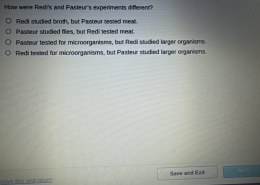How were Redi’s and Pasteur’s experiments different?
Redi studied broth, but Pasteur tested meat.
Pasteur studied flies, but Redi tested meat.
Pasteur tested for microorganisms, but Redi studied larger organisms.
Redi tested for microorganisms, but Pasteur studied larger organisms.
Share


The correct answer is: Pasteur tested for microorganisms, but Redi studied larger organisms.
Explanation: Francesco Redi’s experiments in the 17th century focused on larger organisms, specifically the idea that maggots on decaying meat came from flies, demonstrating that life does not spontaneously generate from non-living matter. He used jars with meat and observed the presence of flies. In contrast, Louis Pasteur’s work in the 19th century focused on microorganisms. He designed experiments with broth and used swan-neck flasks to show that microorganisms in the air caused spoilage, disproving spontaneous generation for microorganisms. This distinction highlights the difference in their research focuses and methodologies.